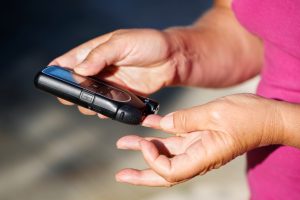
No finger sticks with CGMS.
When you have diabetes, checking your blood glucose levels is just something yo know yo have to do. However, daily checks may not be enough to treat everyone with diabetes. The FDA has recently approved the continuous glucose monitoring system as an effective treatment for diabetes.
What is continuous glucose monitoring?
Continuous glucose monitoring, or CGMS, is a way to measure blood glucose levels in real time without the need for a finger stick. Glucose levels in the tissue fluid are measured by a tiny electrode that is placed under the skin. This data is sent through a transmitter to the monitor where your blood glucose readings are displayed. The CGMS will alert you to high and low blood glucose levels so you can take action. However, one finger stick every 12 hours may be required to calibrate the device and ensure that readings are accurate.
CGMS can be a great way to find out how certain activities, foods, medicines, or other life events such as illnesses may be affecting your blood glucose levels. Also, this device is great for anyone who is having frequent highs and lows or looking improve their A1C. A patient usually wears the CGMS for about 10 to 14 days. Then you will visit a diabetes specialist to review results and devise a plan of action to correct any issues that may present themselves.
Control Blood Glucose Levels
Along with CGMS, there are plenty of ways you can stay on top of your blood glucose.
- Visit your diabetes health care provider often so you can stay on top of any potential issues before they become complications.
- Check your blood glucose levels at home to track your progress. By tracking your highs, lows, and in betweens, you can figure out what times of day you need to improve your diabetes numbers.
- Eat balanced meals and snacks throughout the day that contain a rich source of fiber and protein. Focus your carbohydrate intake on whole grains like brown rice and oats as well as fiber-rich fruit, vegetables, and legumes. This is because fiber slows down digestion, in turn helping improve blood glucose levels
- Stay active each day to help manage your weight and improve insulin sensitivity.
- Track your eating to make sure you are eating at regular intervals and not eating too many carbohydrates at any one meal. Tracking your eating can keep you accountable. If you can identify what parts of your meal plan need improvement, then you will be able to better control your diabetes.
- Take diabetes-friendly supplements such as Glucarex by Vita Sciences. Glucarex contains a blend of compounds such as chromium, alpha lipoic acid, and cinnamon to help support weight loss, metabolism, and blood glucose level control.
-written by Staci Gulbin, MS, MEd, RD, LDN
Sources:
Joslin Diabetes Center (accessed October 2, 2017) “How Does Fiber Affect Blood Glucose Levels?” http://www.joslin.org/info/how_does_fiber_affect_blood_glucose_levels.html
Medtronic (accessed October 2, 2017) “Continuous Glucose monitoring”
Preidt, R. (September 28, 2017) “FDA Approves New Continuous Glucose Monitor for Diabetes”
Wynn, P. (March 10, 2017) “New Diabetes Products for 2017: Glucometers and CGMS”